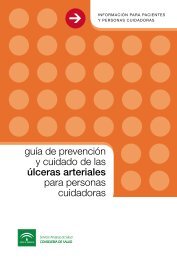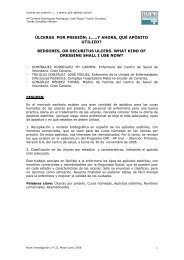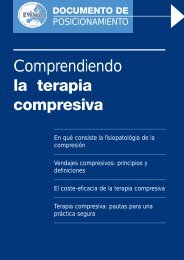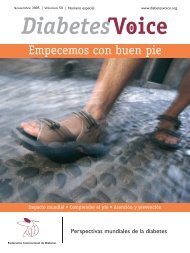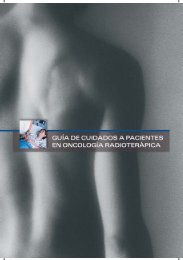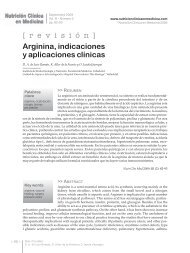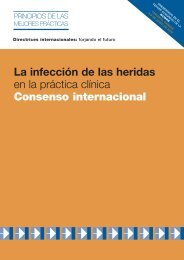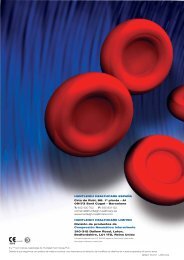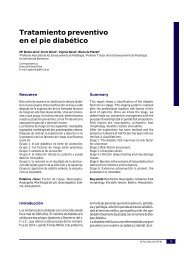Descargar - Úlceras.net
Descargar - Úlceras.net
Descargar - Úlceras.net
- No tags were found...
You also want an ePaper? Increase the reach of your titles
YUMPU automatically turns print PDFs into web optimized ePapers that Google loves.
THE ROLE OF HYPERBARIC OXYGEN THERAPY IN THE TREATMENT OF DIABETIC FOOT ULCERS ■ 129COST-EFFECTIVENESS-OURINSTITUITIONAL ANALYSISHyperbaric chamber were installed in theAutonomic Region of the Azores in order tosupport the touristic activity (recreation andprofessional diving). As diving accidents followa seasonal distribution well below the chamberscapacity, it was necessary to guaranteethe chamber maintenance and to keep theprofessional team proficient in chamber ope -ration. Therefore, the hyperbaric chamberswere installed in the hospitals, which allowedto start the regular hyperbaric medicine acti -vity. In our Institution, a multiplace chamberwas installed.In our unit, activity costs are monthlyaccounted, including expenses with staff, me -dication and consumables. In the analysisbelow, costs with infrastructure and equipmentwere not accounted for. In 2011, thecost per session, per patient was 33 €.Considering that the Portuguese nationalhealth system determines a refund value of62,30 € per patient, per session, the costeffectivenessanalysis finds that the chamber iseconomically sustainable. This analysis doesnot include the fees charged to recreationaland professional divers for underwater medicineconsultations.Tabla IIIHyperbaric oxygen treatment-related costsCosts Monthly mean 2011 Total 2011Consumables 326,78 € 3.921,46 €Oxygen 955,41 € 11.464,96 €Staff 3.683,33 € 44.200,00€Total 4.965,52 € 59.586,42 €PATIENT SELECTIONAND MONITORINGThe greatest benefit from HBOT isobserved in patients with hypoxic ulcerswhich have failed to heal with conventionaltreatment, and who have an intact or mildcompromise of arterial blood supply. Inthese, local infection, microangiopathy, autonomicneuropathy, oedema and decreasederythrocyte deformability are responsiblefor a synergic pathway leading do localhypoxia and ulceration (28).According to Centers for Medicare andMedicaid Services Guidelines, a patient musthave Diabetes and a Wagner 2 or higherwound of a lower limb resulting from diabetesthat has not responded to standardwound care to qualify for HBOT (50).Several methods may be employed toselect patients-invasive measurement of tissuepartial oxygen pressure, duplex ultrasonography,Doppler flowmetry, arteriography,mag<strong>net</strong>ic resonance imaging, positronemition tomography scan and near infraredreflectance spectroscopy (51) and do notpreclude a complete previous vascularassessment with revascularization if indica -ted and if feasible. If correctable arterialinsufficiency is not recognized, the patientwill not respond in a durable fashion toHBOT (52).However, transcutaneous oxygen pressureTcPO 2has been found to be predictivein determining which candidates may besuitable for HBOT. Many factors mayinterfere with the determination of TcPO 2(skin thickness, oedema, skin temperature,respiratory and cardiac condition, posi -tioning of the electrode) (53). Fife et al (54)found in a retrospective analysis of 1 144patients that an in-chamber TcPO 2cutoff of200 mmHg might be discriminating betweensuccess and failure of HBOT, and thatcombination of a sea-level air TcPO 2< 15mmHg and a TcPO 2< 400mmHg in thechamber predicted failure of HBOT with areliability of 75.8% and a positive predictivevalue of 73.3%. In general, HBOT is mostsuccessful when periwound TcPO 2is < 40mmHg in normobaric air, increases morethan 10 mmHg in normobaric 100% O 2andincreases more than 200mmHg underHBOT (54).





